Why do Indians (Hindus) do namaste with folded hands (Prostrations)? | Why do we fold hands in Namaste? | What is the significance of folded hands? | What is the greeting with folded hands? | What is the history of folding hands? | Scientific reason behind joining hands to greet | Joining both palms together to greet
Namaste friends, how are you doing today? Welcome to #BhagavanBhakthi website / blog.
Bhagavan Lord Sri Vishnu (Krishna, Rama, Trivikrama, Narasimha, Vamana, Vasudeva, Mukunda) and Goddess Lakshmi (Rukmini, Satyabhama, Sita, Kamala, Maya) blessings to you and your family!
In this website / blog, you will always learn about #Hinduism #Sanskrit language.
Also subscribe to my YouTube channel from this link #BhagavanBhakthi to view videos about #Hinduism #Sanskrit language.
Just before going to “Why do Indians (Hindus) do namaste with folded hands (Prostrations)? | Why do we fold hands in Namaste? | What is the significance of folded hands? | What is the greeting with folded hands? | What is the history of folding hands? | Scientific reason behind joining hands to greet | Joining both palms together to greet“, let us have a brief some brief information.
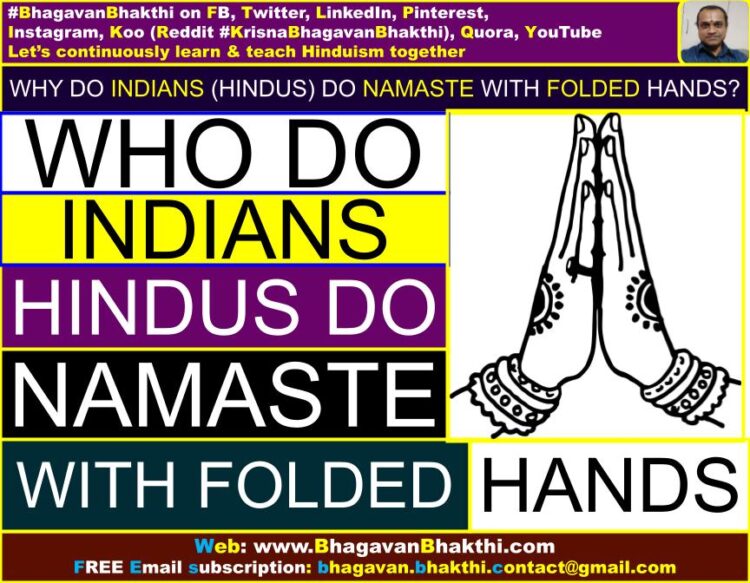
Hinduism is the most oldest and most perfect Dharma on earth. There is no match between Hinduism and other religions on earth.
Hindu Sanatana Dharma is existing since the ‘aadi kalam’ (grand unknown time frame) and will exist until the ‘ananta kalam’ (grand infinite time frame).
Hindus are the only one who give the highest respect to each and everyone on this earth. Whether welcoming someone, or telling goodbye to someone, it is Hinduism who teaches the most correct way of greeting.
We Hindus not only greet someone physically, but also we do it from our mind (manasa) and brain (buddhi). For this reason, Hinduism is the most perfect Dharma on this earth.
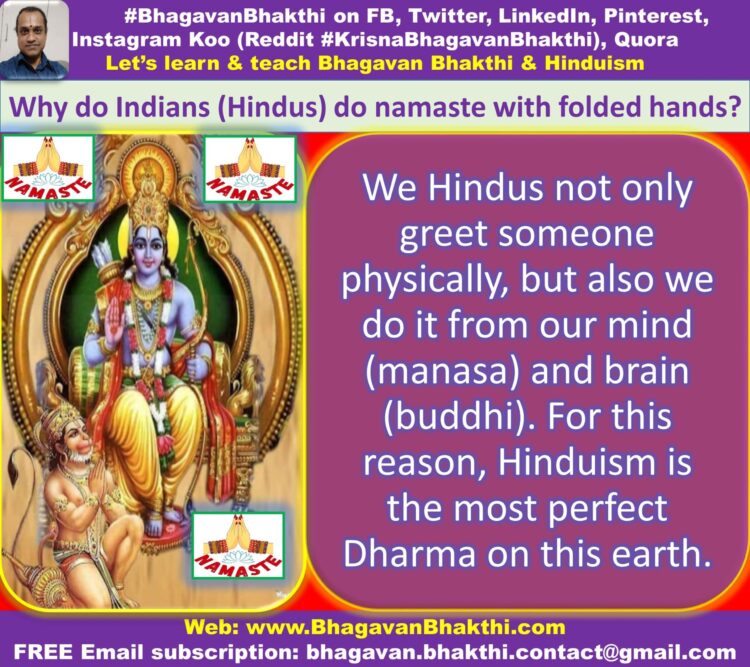
As said in ‘Sri Vishnu Sahasranama Phala Shruti’ shloka 33:
कायेन वाचा मनसेन्द्रियैर्वा बुद्ध्यात्मना वा प्रकृतेः स्वभावात् ।
करोमि यद्यत्सकलं परस्मै नारायणायेति समर्पयामि ॥ 33 ॥
ಕಾಯೇನ ವಾಚಾ ಮನಸೇಂದ್ರಿಯೈರ್ವಾ ಬುದ್ಧ್ಯಾತ್ಮನಾ ವಾ ಪ್ರಕೃತೇಃ ಸ್ವಭಾವಾತ್ ।
ಕರೋಮಿ ಯದ್ಯತ್ಸಕಲಂ ಪರಸ್ಮೈ ನಾರಾಯಣಾಯೇತಿ ಸಮರ್ಪಯಾಮಿ ॥ 33 ॥
kāyēna vācā manasēndriyairvā bud’dhyātmanā vā prakr̥tēḥ svabhāvāt।
karōmi yadyatsakalaṁ parasmai nārāyaṇāyēti samarpayāmi॥ 33॥

Meaning of the above shloka : kāyēna = Bodily, vācā = From voice (tongue), manasēndriyairvā = From mind and indriyas (Senses), bud’dhyātmanā = From brain, vā = And, prakr̥tēḥ = Naturally, svabhāvāt = As a habit,
karōmi = I have to do, yadyat = Whatever it is, sakalaṁ = Everything, parasmai = Anything else, nārāyaṇāyēti = For Bhagavan Sri Narayana (Vishnu), samarpayāmi = Dedicated (Doing arpana).
Translation of the above Shloka : Whatever I / We perform as an individual or a group, I (We) have to do it by giving 100% with my / our body, speech, mind, sense, using my / our Intellect, natural tendencies of my / our mind.
Whatever I / We do, have to be done by surrendering anything and everything at the Lotus Feet of Bhagavan Sri Narayana (Vishnu), I dedicate it all to those works to Supreme Bhagavan Sri Narayana (Vishnu).
The above shloka very clearly shows and says that, we have to prostrate (namaste) in front of Bhagavan Sri Vishnu or others if we need to gain something. This something can be either material things or spiritual things.
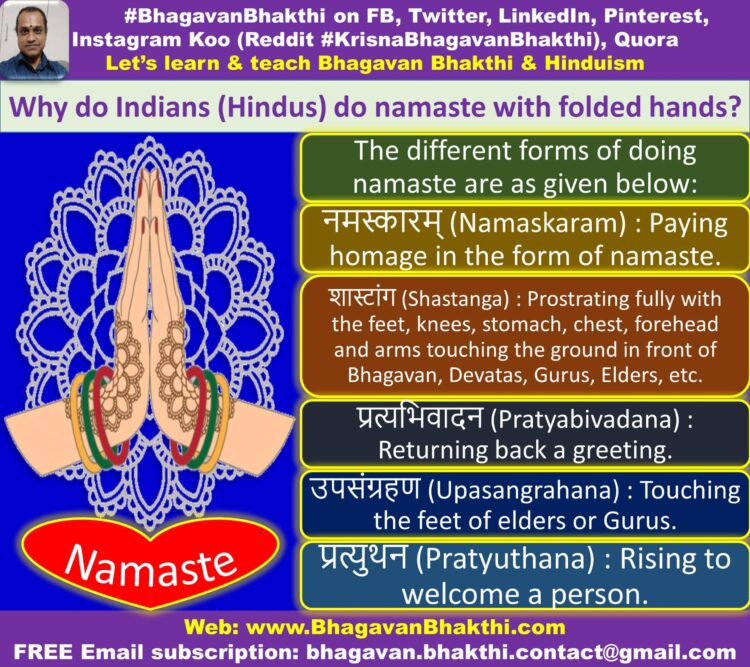
The different forms of doing namaste are as given below:
नमस्कारम् (Namaskaram) : Paying homage in the form of namaste. |
शास्टांग (Shastanga) : Prostrating fully with the feet, knees, stomach, chest, forehead and arms touching the ground in front of Bhagavan, Devatas, Gurus, Elders, etc. |
प्रत्यभिवादन (Pratyabivadana) : Returning back a greeting. | उपसंग्रहण (Upasangrahana) : Touching the feet of elders or Gurus. | प्रत्युथन (Pratyuthana) : Rising to welcome a person. |
All rules are prescribed in our shastras (scriptures) as to who should prostrate to whom. Family name, age, wealth, moral strength, spiritual knowledge, etc. in ascending order of important qualified men / women to receive respect.
For this reason, even though a king been a ruler of the land, should do namaste and / or prostrate before a spiritual Guru.
Hindu divine epics like the Mahabharata, Ramayana, Puranas, etc. have innumerable stories highlighting the aspect of doing namaste (prostration).
This tradition thus creates an environment of mutual love and respect among people ensuring harmony in the family and in turn in the whole society.
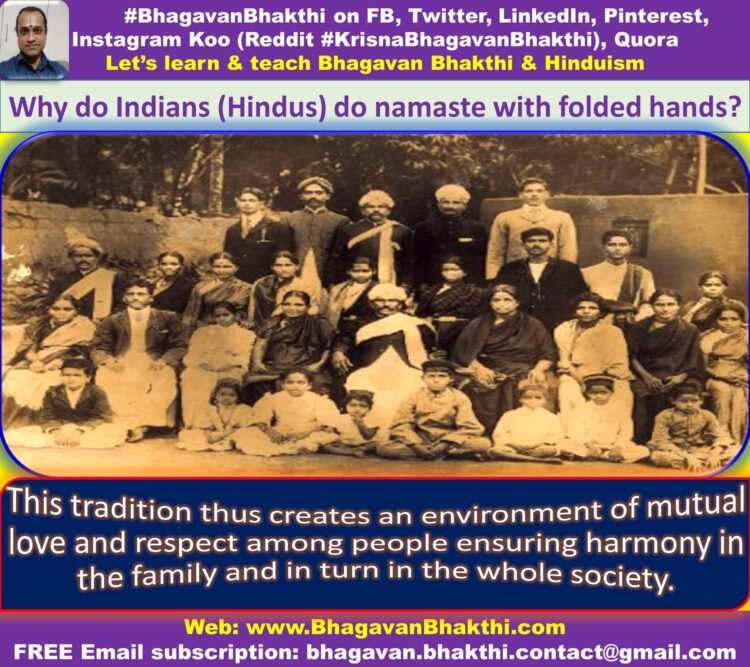
We have to surrender ourselves with 100% dedication, that is, with our body, mind, soul, senses, speech, intellect, naturally, only after this we will be known as a devotee of Bhagavan Sri Vishnu or any other Devatas / Demigods or Guru or Elders.
Indian Hindus greet each other with folding and do namaste to Bhagavan Sri Vishnu or other Devatas or Guru or Elders.
The two palms (hands) are placed together in front of the chest and the head bows whilst saying the word namaste or namaskar or namaskara or namaskaram.
This simple, but dedicated greeting is for all, that is, he / she may younger than us, of our own age, those older than us, friends and even strangers, doing namaste is the ultimate prostration.
But, we should always remember that elders should do namaste to younger people. Only younger people have to do namaste to elders and not vice-versa.
Anyone can do namaste to Bhagavan Sri Vishnu, or other Devatas (Demigods) or Guru or Elders. There are five forms of formal traditional greeting enjoined in the shastras of which doing namaste or namaskaram is one.
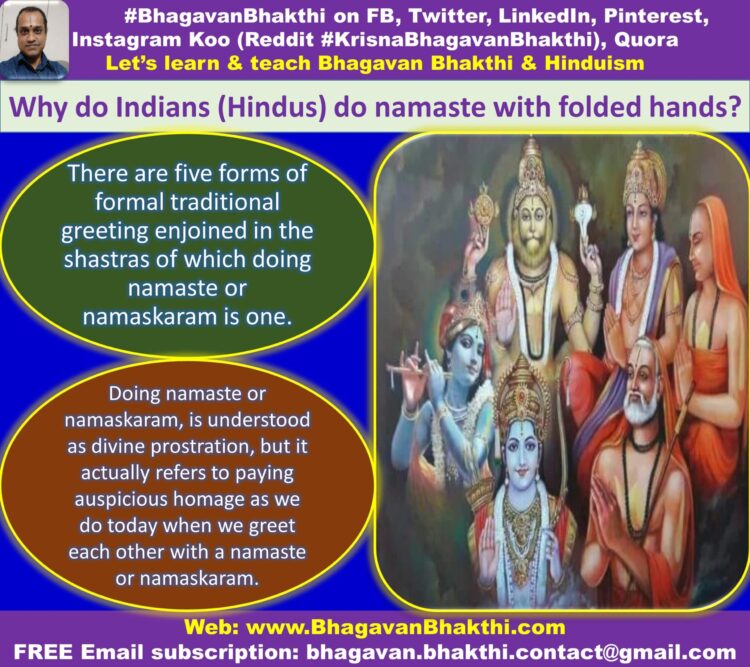
Doing namaste or namaskaram, is understood as divine prostration, but it actually refers to paying auspicious homage as we do today when we greet each other with a namaste or namaskaram.
Namaste or namaskaram could be just a casual or formal greeting or it could be a culture convention or it could be an act of divinely worship. But, there is much more to it than just meeting the eye contact or two ore more person(s).
In Sanskrit: namaste = नमः + ते । ನಮಃ + ತೆ । namaḥ + te | namah + te = namaste.
Namaste means, I bow down to you, my greetings to you, my salutations to you, my prostrations to you, etc. Here namah = namah and te = to you.
Namaha can also be literally interpreted as “na ma” (not mine).
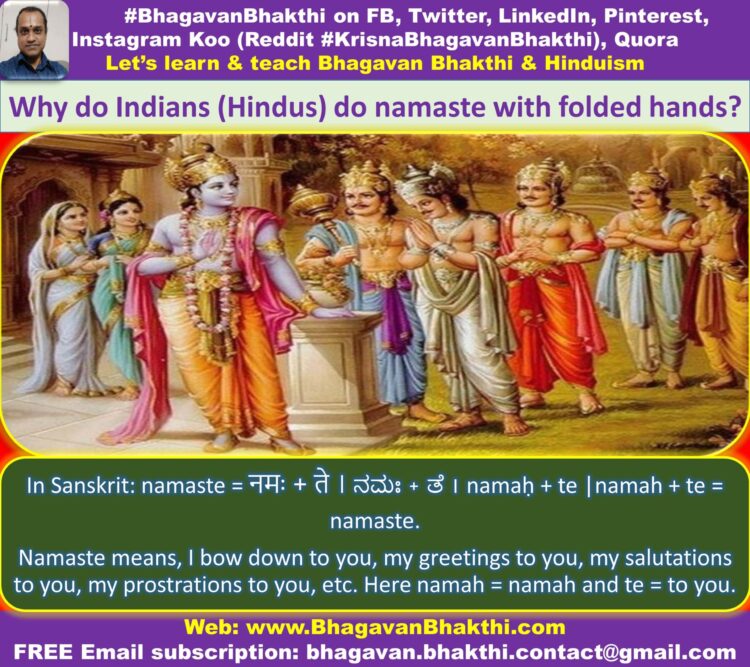
Namaste, has a divine spiritual importance of negating or reducing one’s self pride and / or ego in the presence of another.
The correct meeting between two or more people is the meeting of their minds. Just meeting body is not at all enough. But meeting two minds is highly important.
When we greet another person(s), we do so with namaste, which means, “may our minds meet,”. This is indicated by the folded palms (hands) placed in front of the वक्षस्थल / ವಕ್ಷಸ್ಥಳ / vakṣasthaḷa (chest).
When we bow down our head, we show the gracious form of extending respect, friendliness, love, modesty, humility, etc. The spiritual meaning is even more deeper. Let’s know that too.
The divine life force, the sanctity shows that the Bhagavan Sri Vishnu (Ishwar / Brahman) in me is the same in all. Bhagavan Sri Vishnu who is present in me is same as yours.
Bhagavan Sri Vishnu never discriminates anyone. But he blesses and / or punishes us as per our Karmas (Present and previous lives Karmas).

Recognizing this equality or oneness with the meeting of the palms (hands), we prostrate with head bowed the Divinity in the person we meet. This means, we not only do namaste to the person(s) who is in front of us, but also to the ‘antaryami’ (Present inside), that is, to Bhagavan Sri Vishnu.
That is why some times, we close our eyes as we do namaste to elders, divine person, revered person, Guru, Devatas (Demigods), Bhagavan Sri Vishnu, etc.
This gesture is often accompanied by words like “Rama Rama”, “Jai Sri Krishna”, “Namo Narayana”, “Jai Siya Rama”, “Om Shanti” etc.
Above indicates the recognition of the divinity inside us. That is, the ‘antaryami’ (Present inside) Bhagavan Sri Vishnu is present in each and every being and in everything.
When we know this importance, our prostration or greeting does not remain just a superficial gesture or just a simple word, but it paves the way for a divinely deeper communion with another in an atmosphere of divinity, respect, love, etc.
Why do we do namaste (prostration) before our parents and elders?
Indian Hindus do namaste (prostrate) to their elders, parents, elders, noble souls, etc. by touching their feet.
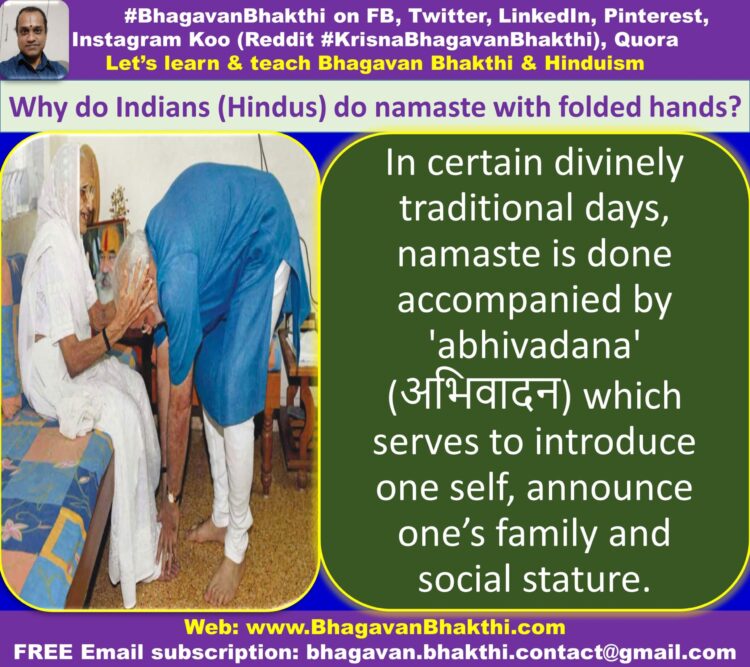
All the above people in turn bless us by placing his or her hand on or over our heads. Namaste is done on daily basis, when we meet elders and particularly on very important days and occasions like the festivals, beginning of a new task, birthdays, etc.
In certain divinely traditional days, namaste is done accompanied by ‘abhivadana’ (अभिवादन) which serves to introduce one self, announce one’s family and social stature.
A person stands on his feet and touching the feet in prostration position is a sign of respect for the merit, dignity, age, maturity, nobility and divinity that our elders personify.
This symbolizes our recognition of their (elders) selfless love on us and the sacrifices that they have done for our welfare, to build our future, to provide good education, food, clothing, etc.
This is very simple to understand. It is a way of humbly acknowledging the greatness of our elders, parents, etc. This divine tradition shows the strong family bondage, which has been one of Indian’s enduring strengths.
The good wishes (sankalpam) and blessing (ashirvadam) of elders are highly valued in Hinduism evey today.
We prostrate to seek the blessings from our elders. Good thoughts always create positive vibrations. Good wishes coming out from a heart full of love, divinity and nobility have tremendous strength.
When we prostrate with respect, humility, etc., we invoke the good wishes and blessings of elders, which flow in the form of positive energy which in turn acts as an armor to us.
Whether in the standing or prone position, this is why the posture assumed, enables the entire body to receive the energy thus received.
More information will be added to this on regular basis. Please this post and other posts of this website / blog to get the updated information.
To know more about Hinduism and Sanatana Dharma, click this link: Hinduism (Sanatana Dharma) on Bhagavan Bhakthi website
Dear friends, if you need any clarifications about this post, kindly let me know, I will definitely try to answer all of them.
Also your one LIKE, one COMMENT, One Share, one SUBSCRIPTION is highly important.
This will help to know the quality of this content and also it will be helpful to know if any improvements is required for the content.
If you feel this content is useful to you and has helped you to improve your knowledge, kindly share this with your well-wishers.
Because “SHARING MEANS CARING”.
For receive FREE EMAIL SUBSCRIPTION about #BhagavanBhakthi, you can send an email to [email protected] from your email ID.
NAMASTE!
SRI GURUBHYO NAMAHA
OM NAMO NARAYANAYA
Sri Krishnaarpanamastu
Share in Social Media
Very good informational perform
Namaste when i visit my gurus worship house.
Candelario Esquilin
Professional Engineer
U.S.Army Veteran
Candelario Esquilin,
Thanks for your comment. Keep in touch.
Have a blessed life!